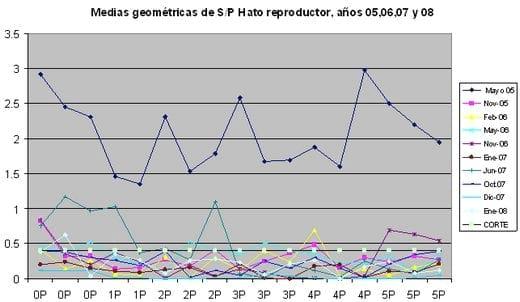Antibodies against PRRSV
Use of neutralizing specific avian antibodies against PRRSV
Published: January 30, 2012
By: Francos T. A, Lucio E, Herrera J.D., Chong C. and Morales A. (Grupo IDISA)
ABSTRACT
This document focuses on the use of a program based on specific avian antibodies to neutralize PRRSV in a multisite farm of 1,100 swine in Central Mexico; farm stability is shown in S/P values. High values when starting program and a decrease as the program continues; also the samples as the program develops along with a repopulation in 2006 and 2007 with 700 replacement sows negative to PRRSV without S/P level changes in the farm.
One of the main problems of PRRSV infection in swine is the periodical presence of disease outbreaks due to virus persistance in some animals, the short immunity of recovered animals and repopulation animals introduction to site one. All of the afore mentioned may or may not cause an economic problem in the reproductive area, but it does generate economical losses in nursing, weaning and growth in swine born post site one infection. Economical losses of this type are produced by infected animals subpopulations generation (infected, negative or persistent) moved from one site to another.
Material and methods.
The farm is located in Central Mexico; it is a multisite farm with an installed production capacity of 1,100 sows, the facilities are technified and serologically positive to PRRSV, Salmonella, Micoplasma, Porcine Influenza, H. parasuis, S. suis and Swine circovirus.
The farm started operations in January 2004, on April of the same year swine were infected with PRRSV from May 2004 to March 2005 using a commercial PRRSV vaccine which was discarded when a stronger outbreak occurred. The use of an immunoglobulins program began on June 2005 and is still in use in the farm, serological follow ups have been performed every 4 months and by means of ELISA tests the S/P movement in sows has been determined; the immunoglobulins program consists of a general application to all swine in the farm of 5mL deep in of the product. The application is repeated 15 days after the first; After these two applications, the program for control consisted in giving sows in reproduction 5mL at the 11th and 13th week of gestation. Newborn piglets are given oral immunoglobulins during the first 12 hours after birth.
Results.
Results obtained in site one sows samples during 2005, 2006, 2007 and early 2008 show how the farm was, and how swine stability was achieved (as observed in low S/P's) during the program. This is not only seen in site one; decreased mortalities in sites 1, 2 and 3 as well as a decrease in medication expenses due to PRRSV shedding were also observed in the production line; it is noteworthy to say that during 2006 and 2007, 700 replacement sows negative to PRRSV were introduced to the farm.

Discussion
The results shown do not have references since we are the only company working on avian neutralizing antibodies against PRRSV, nevertheless they are immunologically speaking similar to those in passive immunity by Dr. Osorio et al in the University of Nebraska, in which he used swine antibodies to alleviate others from PRRSV infection.
References:
Immunology veterinarian. Ian Tizzard., 1998.
Francos TA, Herrera JD. IGy neutralizing antibodies against PRRSv reduce viral movement in a positive faro unit. International PRRS symposium, 2007
Osorio et: al. Role of neutralizing antibodies in PRRSV. ( protective immunity) Veterinary Immunology and Immunophatology. 2004, pag 131 a 155.
Related topics
Authors:
Join to be able to comment.
Once you join Engormix, you will be able to participate in all content and forums.
* Required information
Would you like to discuss another topic? Create a new post to engage with experts in the community.
Create a post





.jpg&w=3840&q=75)